
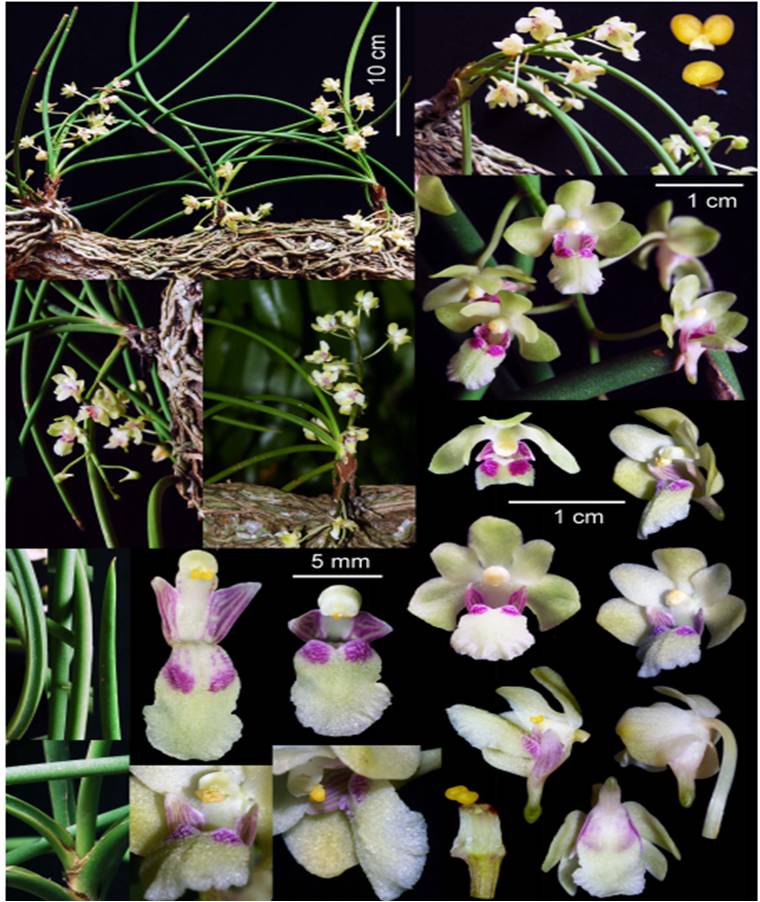
Lan giáng hương phong có kích thước trung bình từ 20 cm đến 30 cm, lá hình trụ tròn, phần cuống lá có rãnh không rõ rệt dài khoảng 20 cm. Thân không phân nhánh. Rễ nhiều, màu trắng mọc dày ở phần gốc.
Cụm hoa chùm một, hoa to khoảng 1 cm, màu xanh nhạt, lưỡi có 2 chấm mầu tím, mọc thành chùm 15 – 20 bông cuống màu xanh lá cây, hoa mọc từ lá nách lá gần gốc thân , hoa mọc thẳng, cứng, dài 2-5 cm , 2,5-3 mm. Lá bắc hoa nhỏ, dựng lên, hình tam giác rộng, gần hình trứng.
Lan giáng hương phong được tìm thấy tại vùng Ninh Thuận ở miền Nam Việt Nam. Trong các khu rừng nguyên sinh thường xanh khô ven biển nhiệt đới gió mùa trên đá silicate ở độ cao trên mực nước biển 50-150m. Hoa nở từ tháng Hai đến tháng Ba hang năm.
Đây là loài hoa lan thứ 8 thuộc giống Aerides sp tìm thấy ở Việt Nam và là loài thứ 12 trên thế giới.
Một Cây Lan Mới Cho Thế Giới: Aerides phongii, một câu chuyện sưu tầm trên trang Hoa Lan Việt Nam
“Chào Bác!
Cháu mới kiếm được 1 cây lan, theo nhận định ban đầu của cháu thì nó thuộc dòng Tóc tiên – Holcoglosum. Cháu tìm hiểu thì không có thông tin về cây này nên muốn nhờ Bác liên hệ và tìm hiểu thêm về nó. Hy vọng là một cây mới cho Vietnam. Cháu mô tả sơ bộ thông tin:
– Cây dài trung bình từ 20 cm đến 30 cm, lá hình trụ tròn, phần cuống lá có rãnh không rõ rệt dài khoảng 20 cm.
– Hoa to khoảng 1 cm, mầu xanh nhạt, lưỡi có 2 chấm mầu tím, mọc thành chùm 15 – 20 bông Cây này được tìm thấy tại vùng Khánh Hòa – Vietnam.
Cháu gửi kèm một số hình ảnh để Bác tham khảo.
Cháu sẽ chuẩn bị và gửi thêm thông tin chi tiết hơn.
Chào Bác!
Nguyễn Phong”
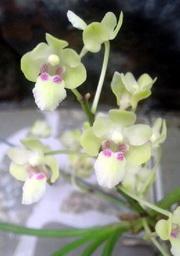
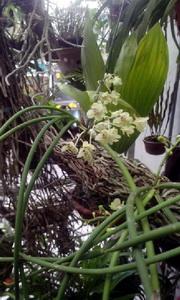
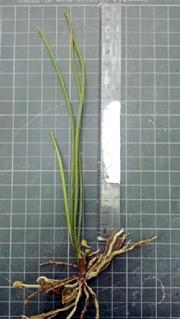
Mới nhìn qua tôi nghĩ đó là cây Holcoglossum flavescens, nhưng anh Phong cho biết thêm:
“Cây này nhiều khả năng cây này không phải cây Holcoglosum flavescens vì:
Cháu đã trồng cây Holc. flavescens rồi, cây này nhỏ hơn cây cháu đề cập nhiều, kết cấu lưỡi khác, số lượng hoa trên một chùm ít hơn nhiều…
– Cây cháu đề cập lớn hơn nhiều, cây trưởng thành dài đến 30cm, số lượng hoa trên một chùm rất nhiều, có chùm lên tới 30 bông và phân chia nhiều nhánh. Bông hoa đầu tiên nở khoảng ngày 10-2-2014 và hiện nay vẫn chưa tàn (25-2-2014)”.
Nhìn kỹ lại thấy cây lan này thì đúng như anh Nguyễn Phong nói, đó là một cây lan lạ. Tra cứu các tài liệu và hình ảnh nói về các cây Holcoglossum hiện hữu trên thế giới, kể cả các loài cùng chi Aeridinae: Papilionanthe và Paraphalaenopsis, đều có thân đơn và lá hình ống nhưng không thấy có một cây nào tương tự như cây này.
Vội vàng báo cho Tiến sĩ Phan Kế Lộc biết để lấy mẫu vật và thu thập thêm hình ảnh, đồng thời gửi điện thư cho giáo sư Leonid Averyanov với hình ảnh và tư liệu. Khoảng 30 phút sau Leonid Averyanov xác nhận đó là một giống lan chưa từng thấy.
Sau đó mấy ngày Giáo sư Phan Kế Lộc và anh Chu xuân Cảnh lại gửi thêm cho tôi những hình ảnh dưới đây.
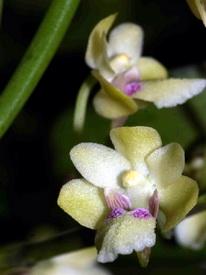
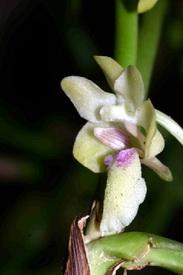
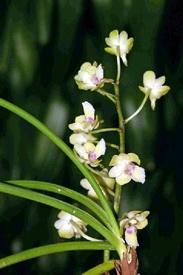
ảnh của GS. TS. Phan Kế Lộc
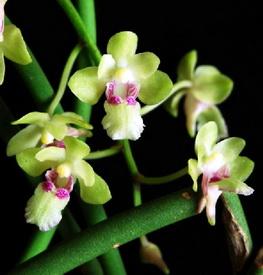
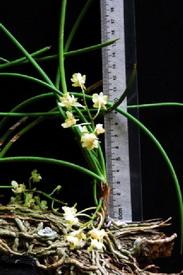
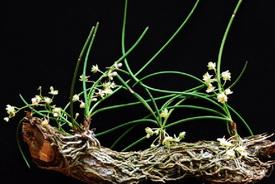
Ảnh của anh Chu Xuân Cảnh
Anh Nguyễn Phong còn cho biết thêm là khúc cây có 3 cây bám vào như hình ở bên trên, đã được anh mua về từ khoảng 3 tháng trước và nở bông hoa đầu tiên vào ngày 10-2-2014 , anh Chu xuân Cảnh đã chụp hình vào ngày 4-3-2014. Như vậy là gần một tháng hoa vẫn chưa tàn. Cũng trong bức hình này, cây lan bên trái có tới 3 chùm hoa tất cả. Đó là những điểm đáng chú ý: hoa đẹp, nhiều chùm, nhiều hoa, lâu tàn và nếu có thêm hương thơm thì thực là: “Hương sắc vẹn toàn”.
Cuối cùng theo tin mới nhất, tiến sĩ Leonid Averyanov vừa mới gửi cho, mới biết rằng: Vì cấu trúc của bông hoa, nên cây lan này được xếp vào loài Aerides (Giáng Hương) chứ không phải là Holcoglossum. (Xin xem nguyên văn bản công bố bằng Anh văn trong tờ Turczaninowia 2014, 17 (0): 00-00) sẽ phổ biến nay mai.)
Việc “Trông gà hoá cuốc này” một phần do vì sự hiểu biết còn non kém, phần vì bị mờ mắt về thân lá của cây lan nên không còn chú trọng đến bông hoa nữa, cho nên đã quên lời của Gunner Seidenfaden, một khoa học gia tên tuổi: Vấn đề chính là phải xem xét cấu trúc của bông hoa sau đó mới đến mầu sắc, và thân lá.
Nhờ sự giới thiệu kịp thời với Tiến sĩ Leonid Averyanov (khi cây còn hoa) đã giúp cho loài Aerides trên thế giới thêm một giống mới, mang một chút âm hưởng Việt Nam: Aerides phongii Aver., sp. nov.
Xin chúc mừng anh Nguyễn Phong và Câu Lạc bộ Tràng An, Hà Nội, một Câu Lạc Bộ có tới 2 người đã mang tên VN vào lịch sử hoa lan thế giới: Chu xuân Cảnh với cây lan hài Paph. canhii và bây giờ là Aerides phongii. Chúc mừng! Chúc mừng!
Xin mượn lại câu kết trong bài nói về Câu Lạc Bộ Tràng An vào 6-5-2010: “Xin ghi nhớ tấm lòng ưu ái của các anh chị em trong CLB Tràng An và mong rằng các anh chị sẽ tìm ra nhiều cây lan mới lạ cũng như gìn giữ được những cây lan gia bảo của chúng ta.”
Một lần nữa xin cám ơn bác Phan Kế Lộc và các anh Phong, Cảnh đã chung sức làm rạng rỡ những cây lan Việt.
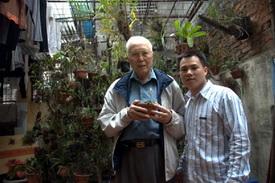
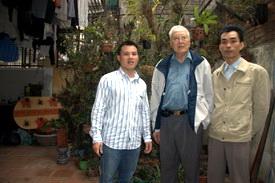
Với cây lan này, loài Aerides trên thế giới sẽ là 12 giống, Việt Nam có 8 giống và tổng số cây lan rừng Việt Nam từ A-Z sẽ là 1154 giống.
(Bùi Xuân Đáng)
Dưới đây là toàn văn bài báo của các tác giả đăng trên Turczaninowia17 (1): 6–9 (2014):
Introduction
Aerides Lour. is a relatively small orchid (Orchidaceae) genus which consists of approximately 21species ranging from India to Papua New Guinea (Christenson, 1993; Kocyan et al., 2008) with main center of species diversity in mainland tropical Asia. Regional floras of the area of highest diversity include 5 species in China, 6–7 in Thailand and Laos, 4 in Cambodia and 7 species in Vietnam (Averyanov, 1994, 2013; Averyanov, Averyanova, 2003; Chen, Wood, 2009; Newman et al., 2007; Orchids of Cambodia, 2014; Schuiteman, de Vogel, 2000; Schuiteman et al., 2008; Seidenfaden, 1988, 1992). One more species of the genus new for science was discovered recently in Pacific coastal forests of southern Vietnam in limited area with arid climate driest in the eastern Indochina. Thus Vietnam becomes certainly the richest country in the world with respect of species diversity of Aerides . Illustrated description of the new species with brief notes on its ecology, expected distribution, assumed protection status, taxonomic position and biology is provided below.
Aerides phongii Aver., sp. nov. (Fig. 1) Described from Vietnam (“Southern Vietnam, Ninh Thuan Prov., Bac Ai Distr., in heavily disturbed primary seasonal tropical broad-leaved lowland woodland on silicate rocky slope. Branch epiphyte on old tree. Rare. Plants were collected and offered for sale on local market by local collectors in February – March 2014, type specimen was purchased by Mr. Nguyen Phong at early March 2014”). Type (“Flowered under cultivation in private garden in Hanoi, collected at 12 March 2014 by Nguyen Phong and Phan Ke Loc P 11235”) – HNU (holotype), LE (isotype).
Monopodial perennial herb with short, erect, unbranched stem to 2(2.5) cm tall, 3–5 mm in diameter. Roots many, at the base of stem, light grey to almost white, rigid, wiry and flexuose, creeping and densely adpressed to substrate. Stem covered with loosely adpressed, overlapping, distichous, partially disintegrated, more or less rigid, brown leaf sheaths, leafy and slightly twisted at apex. Leaves 3–5, distichous, rigid, subulate, canaliculate at lower portion, terete toward acute apex, recurved to arcuate or slightly flexuose, (15)20–30(35) cm long, 3.5–4.5 mm wide, articulate at the base, suddenly broadening at the base into a closed sheath enveloping the stem. Inflorescencea raceme; peduncle green, arising from leaf axil near stem base, erect, rigid, 2–5 cm long, 2.5–3 mm in diameter, bearing 1–2(3) short, small, broadly triangular, obtuse sterile bracts 2–4 mm long; rachis rigid (2)3–6 cm long, with (1)5–12(14) distant flowers. Floral bracts small, erect, triangular to broadly ovate, acute, 1.5–2.5 mm long and wide. Pedicel and ovary white or yellowish-green, shallowly ridged, 1.2–1.6 cm long, curved, slightly flexuose to almost straight. Flowers resupinate, shallowly campanulate to widely opened, (1.2)1.4–1.8 cm across; sepals and petals slightly incurved, white to light yellowish, greenish at apex. Dorsal sepal and petalssubsimilar in shape, ovate to broadly elliptic, 6–7 mm long, 4.5– 5 mm wide, round at apex, petals a little smaller, almost flat, dorsal sepal with slightly reflexed lateral margins. Lateral sepals oblique broadly ovate, concave or with reflexed lower margin, (6.5)7–8 mm long, 5.5–6.5 mm wide, blunt to obtuse. Lip firmly attached to the column foot, not mobile, white to light yellowish, 3–lobed, spurred at the base. Lip side lobes triangular, obtuse, straight, erect, 4.5–5.5 mm long, 2–3 mm wide, broadly attached to column foot, white or light yellowish, with 4–5 broad, purple, longitudinal stripes. Median lip lobe narrowly rhomboid obovate, 8.5–10 mm long, 6–7 mm wide, white or light yellowish, curved, concave, with round apex, finely erose along margin, disk verruculose with 2 large gibbous verrucose purple calluses at center. Spur white or pinkish, broadly conical, (3.5)4–4.5 mm long, 1.5–2 mm wide, attenuate into inflated, slightly laterally flattened green apex. Columnpure white, shortly cylindric, 2–2.5 mm tall and broad, truncate, with slightly concave clinandrium and small 2-lobed rostellum, at front with round concave stigma. Column foot prominent, fleshy, rectangular, slightly incurved to almost straight, 4–5 mm long, 2–2.5 mm wide. Operculum white to light yellowish, hemispheric, 1.5–2 mm in diam., 2-chambered inside, smooth, frontally with a short, triangular beak rounded or blunt at apex. Pollinarium consisting of 2 pollinia, caudicles, stipe and viscidium. Polliniasolid, spherical, 0.6 mm in diameter, yellow, smooth, entire but distinctly notched abaxially. Caudicles very short, insignificant. Stipehyaline, saddle shaped. Viscidiuma thin, flat, round disk. Fruitnot seen.
Etymology
Species is named after its discoverer, Mr. Nguyen Phong.
Ecology
Miniature branch epiphyte. Primary dry evergreen coastal tropical monsoon forests on silicate rocks at elevations 50–150 m a.s.l. Rare. Flowers in February – March.
Distribution
Species probably inhabits seasonal tropical broad-leaved lowland coastal woods and woodlands in Ninh Thuan province of southern Vietnam.
IUCN status
Following to IUCN Red List criteria (IUCN. 2013) species status should be tentatively estimated as endangered (EN) or critically endangered (CR) due to the overall reduction of endemic primary lowland forests and woodlands in the area when remained species populations are restricted to extremely small, highly fragmented subpopulations standing on the verge of full extinction. Timely assessment of the species in nature and its introduction into culture are living important actions for salvation of this interesting orchid which has good prospects for cultivation as miniature ornamental plant.
Notes
Most probably discovered species represents local endemism of ancient xerophilous flora spreading along narrow coastal belt shaded from monsoon winds and experienced by annual precipitation with rains falling during short rain season lasting from the end of September to middle December. This rather limited biogeographic region of Vietnam is recognized in modern geography as climatic area of monsoon tropical climate with warm winter and autumn-winter rains (Averyanov et al., 2003; Nguyen et al., 2000). Newly described species looks appropriately adapted to semi-desert, strongly seasonal climate conditions by its succulent fleshy cylindric leaves, unique in the genus. Plant differs strikingly in its unusual habit from all other its congeners and resembles superficially some species of the genus Holcoglossum Schltr. with which has hardly direct relations. Verruculose lip with two warty purple gibbosities on the disk is another peculiar character which differ new species from all other known species of Aerides . Taxonomically species may be also related to Rhynchostylis Blume and Vanda R. Br., from which it is distinguished by the presence of a well-developed column foot as it is observed in all other species of Aerides . Discovered novelty undoubtedly desires artificial propagation and cultivation as an unusual beautiful miniature ornamental orchid that may be one of the ways for its effective protection.

Fig. 1. Aerides phongii Aver. Flowering plants, flowers and floral details
(all photos from the type specimens by Phan Ke Loc and Chu Xuan Canh, image correction and design by Leonid V. Averyanov).
Acknowledgements
Laboratory studies of discovered species were supported from exploration program of U.S.A. National Geographic Society “Exploration of primary woods along constructed highway Hanoi – Ho Chi Minh for their sustainable conservation (in limits of Ha Tinh and Nghe An provinces of central Vietnam)”.
References
Averyanov L.V. Identification guide to Vietnamese orchids (Orchidaceae Juss.). – St. Petersburg: World and Family, 1994. – 432 p.
Averyanov L.V. New and rare orchids (Orchidaceae) in the flora of Cambodia and Lao PDR // Turczaninovia, 2013. – Vol. 16, № 4. – P. 26–46.
Averyanov L.V., Averyanova A.L. Updated checklist of the orchids of Vietnam. – Hanoi: Vietnam Nat. Univ. Publ. House, 2003. – 102 p.
Averyanov L.V., Loc P.K., Nguyen T.H., Harder D.K.Phytogeographic review of Vietnam and adjacent areas of Eastern Indochina // Komarovia, 2003. – Vol. 3. – P. 1–83.
Chen X.Q., Wood J.J. AerodesLoureiro // Z.G. Wu, P.H. Raven, Hong D.Y. (eds). Flora of China. – Vol. 25. – Beijing: Science Press & St. Louis: Missouri Botanical Garden Press, 2009. – P. 485–486.
Christenson E.Sarcanthinae genera: 10. Aerides // Amer. Orchid Soc. Bull., 1993. – Vol. 62. – P. 595–609.
IUCN.2013. IUCN Red List of Threatened Species. Version 2013.2. <www.iucnredlist.org> (accessed 16 March 2014).
Kocyan A., de Vogel E.F., Conti E., Gravendeel B.Molecular phylogeny of Aerides (Orchidaceae) based on one nuclear and two plastid markers: A step forward in understanding the evolution of the Aeridinae// Molecular Phylogenetics and Evolution, 2008. – Vol. 48. – P. 422–443.
Newman M.F., Ketphanh S., Svengsuksa B., Thomas P., Sengdala K., Lamxay V., Armstrong K. A checklist of the vascular plants of Lao PDR. – Edinburgh: Royal Botanic Garden, 2007. – 394 p.
Nguyen Th.H., Loc P.K., Nguyen T.H. Nguyen.Bioclimatic diagrams of Vietnam. – Hanoi: Vietnam National University, 2000. – 126 p.
Orchids of Cambodia.http://www.orchidcambodia.com (accessed 16 March 2014).
Schuiteman A., Bonnet P., Svengsuksa B., Barthelemy D.An annotated checklist of the Orchidaceae of Laos // Nordic Journal of Botany, 2008. – Vol. 26. – P. 257–316.
Schuiteman A., de Vogel E.F. Orchid genera of Thailand, Laos, Cambodia and Vietnam. – Leiden: Nat. Herb. Nederlands, 2000. – 118 p.
Seidenfaden G.Orchid genera in Thailand XIV. Fifty-nine vandoid genera // Opera Bot. 1988. – Vol. 95. – P. 1–398.
Seidenfaden G. The orchids of Indochina // Opera Bot., 1992. – Vol. 114. – P. 1–502.
L.V. Averyanov
Russian Academy of Sciences, Komarov Botanical Institute
P.K. Loc
Faculty of Biology, Hanoi University of Science, Vietnam National University, Hanoi, Vietnam
C.X.Canh
CARE International in Vietnam, 92 To Ngoc Van, Hanoi, Vietnam



Leave a Reply